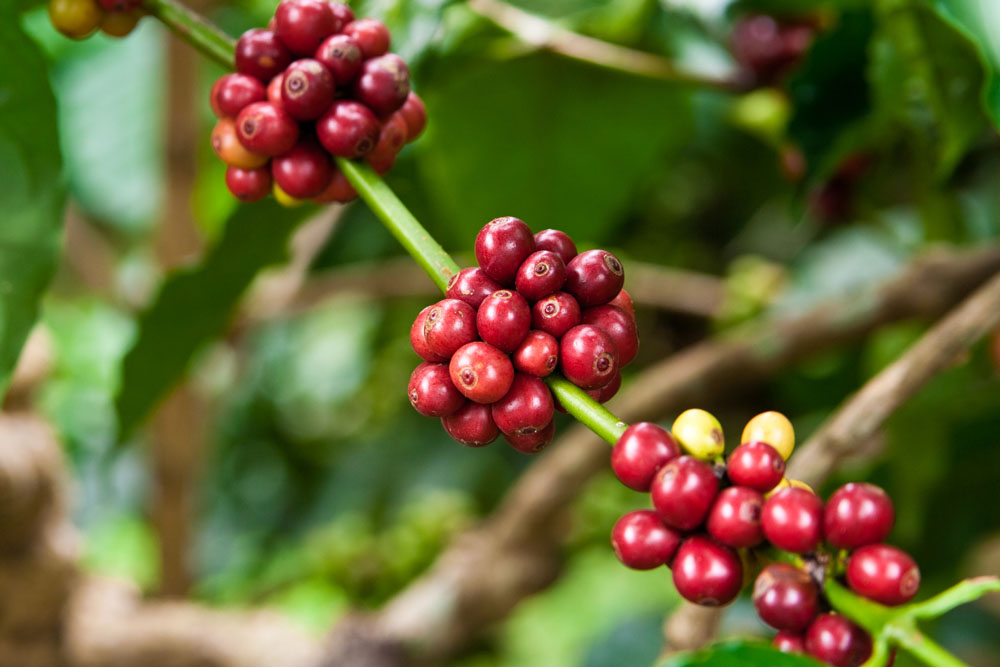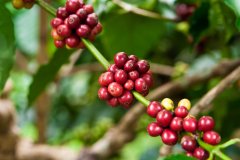African Gilima Manor Tanzania Kilimanjaro Pearl PB Coffee beans
In Tanzania, Mount Kilimanjaro (Mt Kilimanjaro), Africa's highest peak, stands in the northeast. After World War I, it was named Trust. It was once a British colonial rule and became independent in 1964. Bourbon coffee was introduced as early as 1893. The green beans are mainly washed by water. Good quality high-altitude Tanzanian coffee, like Kenya, has active and bright acid performance.

Tanzania coffee producing areas in the north are Moshi, Mbeya and other producing areas around the foothills of Mount Kilimanjaro, and in the south are Songea-Ruvuma areas where the Ruvuma River flows. Due to the different growing terrains, the styles are slightly different. Coffee produced in Ruvuma region of south-west Tanzania has a bouquet and fruity aroma, which is different from coffee produced in Mt Kilimanjaro region of north.
Kilimanjaro is located in the northeast of Tanzania and is Tanzania's largest coffee producing area accounting for 75%. Generally speaking, Tanzania's coffee beans have extraordinary quality. The important producing area is in the mountainous area close to Kenya in the north. Coffee farmers grow coffee 85%. Local coffee farmers grow coffee between 1300-2000m above sea level. Its coffee flavor is different from that of neighboring Ethiopia and Kenya. He has the characteristics of both countries. The body thickness is good and the aroma of fruit and flowers is worth a try. Coffee belongs to dicotyledonous plants. Generally speaking, a coffee cherry fruit normally has a pair of coffee seeds, which is what we call coffee beans. relative to flat beans.(pair of flat-sided beans), also known as caracol or caracolillo, which means small snail in Spanish; The yield of round beans, botanically, is said to be due to uneven pollination.(Arabica coffee species are self-pollinated plants, if a coffee flower has only one ovary, or only one ovary is successfully pollinated, only one seed can be produced), or nutrition is uneven during the growth process (usually more likely to occur in coffee fruits growing at the end of the coffee tree), nutrients are absorbed by only one of the cotyledons, and only the cotyledons that receive nutrients continue to grow into a single oval small egg coffee seed, thus having the name round bean. Normally, coffee plants produce about 3 to 5% of round beans, which are relatively rare in terms of yield, and because of their size and shape, round beans are often selected for sale separately by mesh screening.
This batch of Kilimanjaro pearl round beans, processed by washing, has an acid softness similar to Kenya coffee, a pleasant low acidity, a round taste and a medium viscosity. Fine Tanzanian beans taste similar to Kenyan coffee in texture, but overall quality is comparable to Kenyan coffee. In addition to the lingering finish, fruit and fruit acids are also combined, acidity is weaker than Kenya coffee, is a relatively mild coffee.
Important Notice :
前街咖啡 FrontStreet Coffee has moved to new addredd:
FrontStreet Coffee Address: 315,Donghua East Road,GuangZhou
Tel:020 38364473
- Prev

Antigua Coffee, Guatemala introduces Atitlan, one of the five major volcanic producing areas.
The aroma of coffee liberates all forms, hearts and national boundaries. Through coffee, the mood leaves the country at any time and lands in a strange country half a world away. Even at the end of the world, you can share a mood. Antigua was the capital of the Spanish colonial period in 1543. Although this emerald-like valley has been in all directions, layers upon layers, deliberately waiting for development and crisis since ancient times.
- Next

African Gilima Manor Tanzania Kilimanjaro Pearl PB Coffee beans
Mount Mt Kilimanjaro, the highest peak in Africa, stands in the northeast of Tanzania, known as Trusteeship after World War I. it was once under British colonial rule and became independent in 1964. Bourbon strain coffee was first introduced and planted in 1893, raw beans were mainly treated with water washing, and high-quality high-altitude Tanzanian coffee was of good quality, just like Kenya has active and bright acid performance. Tanzania
Related
- Does Rose Summer choose Blue, Green or Red? Detailed explanation of Rose Summer Coffee plots and Classification in Panamanian Jade Manor
- What is the difference between the origin, producing area, processing plant, cooperative and manor of coffee beans?
- How fine does the espresso powder fit? how to grind the espresso?
- Sca coffee roasting degree color card coffee roasting degree 8 roasting color values what do you mean?
- The practice of lattes: how to make lattes at home
- Introduction to Indonesian Fine Coffee beans-- Java Coffee producing area of Indonesian Arabica Coffee
- How much will the flavor of light and medium roasted rose summer be expressed? What baking level is rose summer suitable for?
- Introduction to the characteristics of washing, sun-drying or wet-planing coffee commonly used in Mantenin, Indonesia
- Price characteristics of Arabica Coffee Bean Starbucks introduction to Manning Coffee Bean Taste producing area Variety Manor
- What is the authentic Yega flavor? What are the flavor characteristics of the really excellent Yejasuffi coffee beans?

